If you are the owner of a Great Dane, it is important that you are aware of angular limb deformity. Many people mistake this more serious conditioning with simple knuckling in puppies!
Angular limb deformities result in deformed bones that can cause your dog pain and mobility problems. It may require surgery to correct.
In this article, we will discuss what angular limb deformity is, the difference between ALD and knuckling, how to spot it in your dog, and what treatment options are available.
Angular Limb Deformity in Great Danes
What does Angular Limb Deformity Look Like?
Angular limb deformity can be mild or severe and may present itself in one or both legs. The signs of ALD include:
* Lameness or stiffness in the affected limb
* Pain
* Muscle wasting
* A flat foot or feet that turn out away from the body
* Weak pasterns or ankles
* Joint deformity
* Crooked, bent or deformed feet and ankles
A dog with more advanced ALD may walk with a floppy, turned-out foot that faces outward
ALD is not to be mistaken with knuckling or Queen Anne (“Ballet”) feet.
This Great Dane below has a severe case of Angular Limb Deformity.
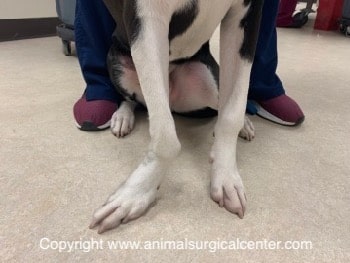
Why are my dog’s legs bowed?
A dog’s legs can be bowed for a number of reasons, including Carpal Valgus or knuckling, Angular Limb deformity, poor nutrition, neglect, injury, birth defects, or congenital disorders.
If you notice anything unusual about your dog’s feet or limbs, especially while they are growing, it’s important to take them to the vet for an evaluation.
Dogs are exceptionally good at hiding pain, so don’t take ‘acting normal’ as a sign that your dog is ok. A dog with an affected limb may or may not limp.
Angular limb deformity, also known as ALD or Angular Stance Deformity, is a condition that causes the bones in a dog’s legs to grow at abnormal angles.
This can cause pain, lameness, and mobility problems.
ALD will often present initially as mild changes to the foot and ankle that may be mistaken for other things, such as knuckling.
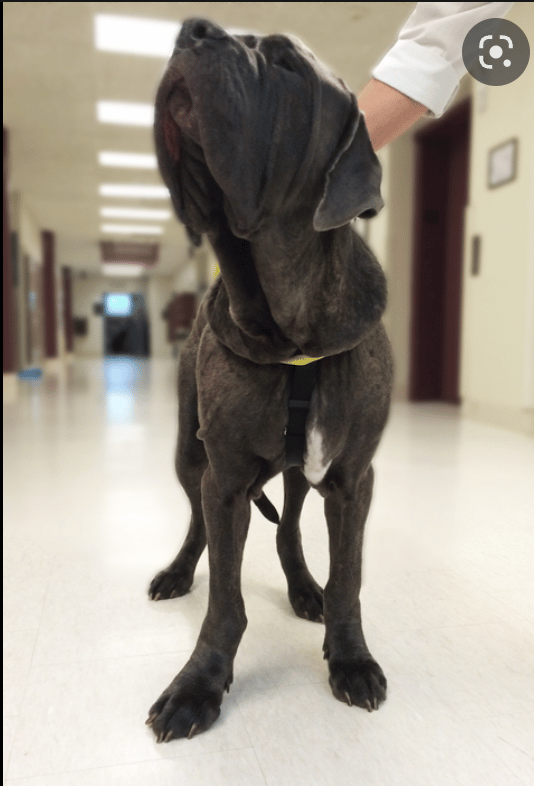
Can a dog live with Angular Limb Deformity?
While a dog can live, move and even play with any number of odd conditions, Angular Limb Deformity should be evaluated by a board-certified veterinary orthopedic surgeon as soon as possible.
Many times, the deformity can be corrected surgically. The earlier the surgery is performed, the better the outcome for your dog.
Left untreated, Angular Limb Deformity can cause your dog a great deal of pain and will likely lead to arthritis later in life.
Your dog will walk with an altered gait, which can be hard on the healthier or more normal joints.
Severe deformities will eventually make it hard for your dog to walk at all.
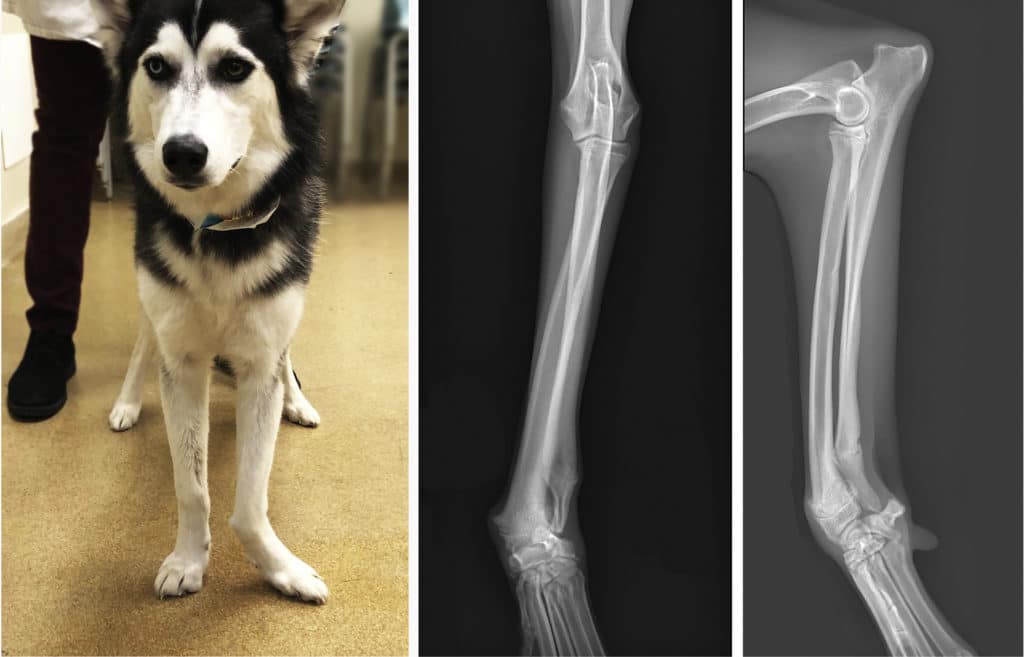
Types of Bowed Legs in Dogs
In order to better understand angular limb deformity, it is important to first understand the different types of bowed legs in dogs.
We will cover knuckling, HOD, Panosteitis, Angular Limb Deformity, genetics, birth disorders, OCD, and more.
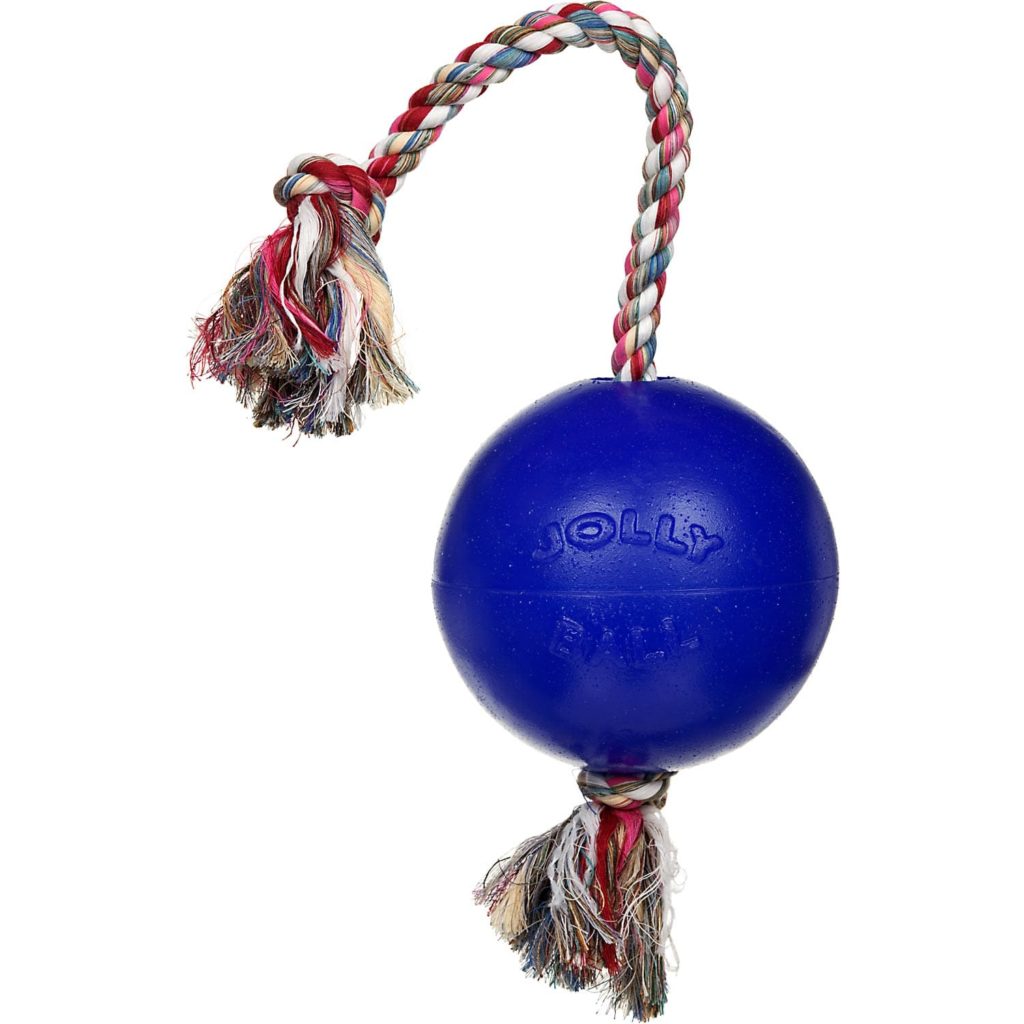
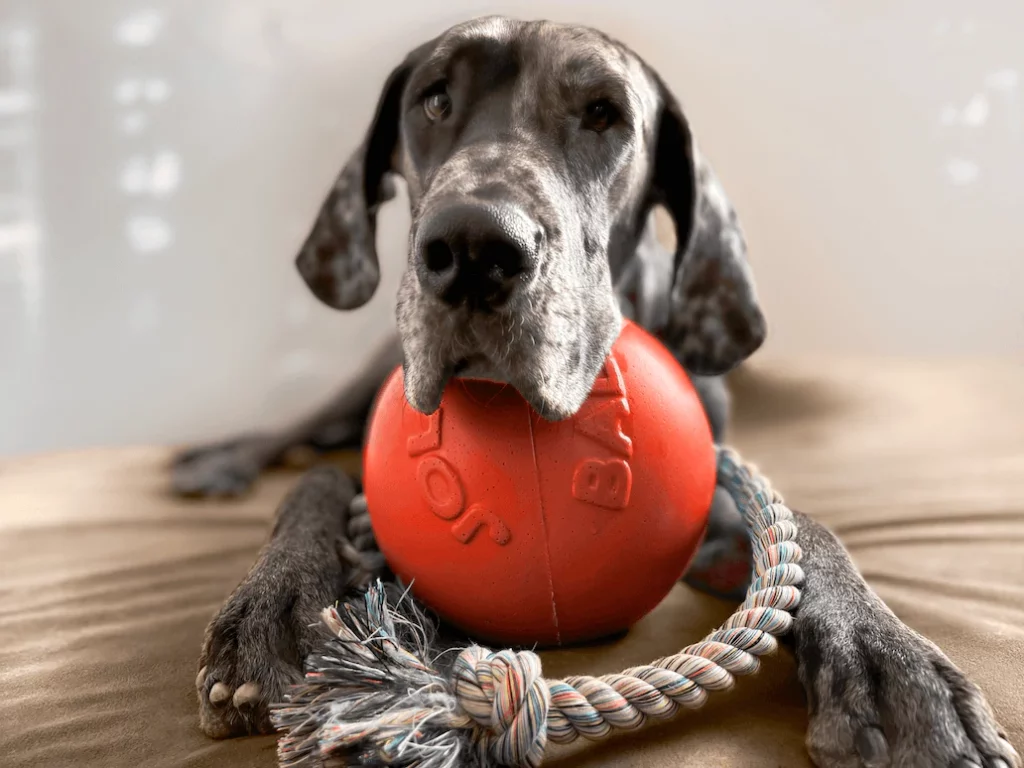
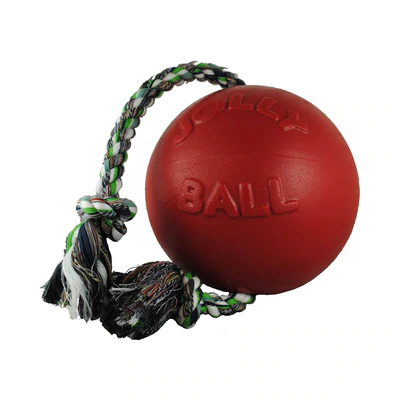
Knuckling in puppies
Knuckling is a condition most often seen in large and giant breed puppies during their rapid growth phase.
A puppy that is knuckling will have feet that appear to bow out, up and over the top of the toes. This is caused by nutritional deficiencies but also may be the result of weak muscles and tendons in the feet.
Correct nutrition and strengthening the feet with gentle forms of exercise on soft surfaces can help puppies recover from knuckling.
Appropriate nutrition is also required. Large and giant breed dogs need correctly balanced large or giant breed puppy food.
Should I Feed Puppy or Adult Food to my Dog?
The HELLO DANES Puppy Knuckling Resource Page
Nutrition for Large + Giant Breed Puppies
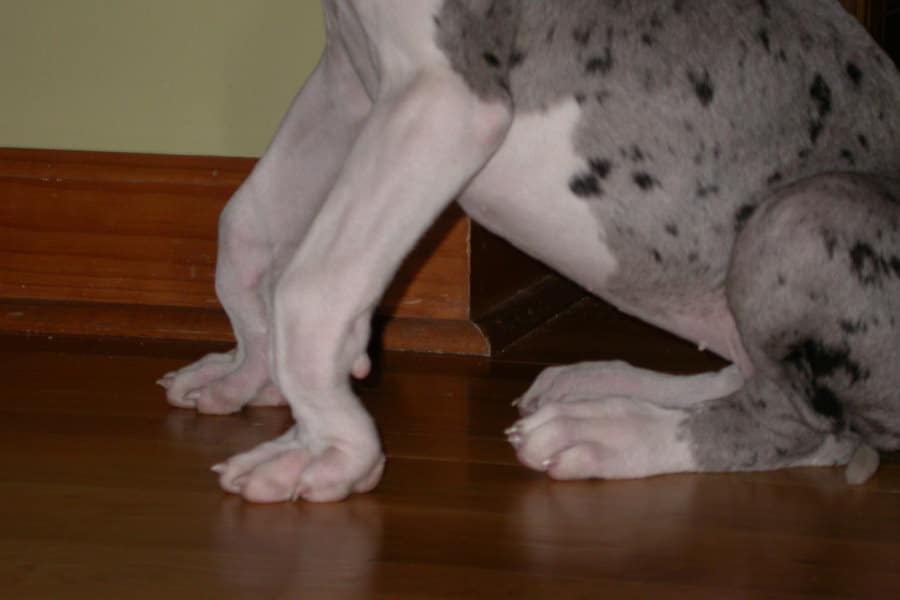
HOD or Panosteitis
HOD or Panosteitis is a disease of the long bones that causes lameness and pain. It is seen most often in large and giant breed dogs between the ages of four and fourteen months old. A dog with HOD may limp and act painful.
The cause of HOD is unknown but it may be related to rapid growth, genetics, or nutrition.
Panosteitis (also known as growing pains) can also result in pain, lameness, and swelling.
Both often present with limbs that look ‘off’.
Angular Limb Deformity
Angular limb deformity (ALD) is the purpose of our article today. ALD is believed to be caused by damage to the immature growth plates and may be made worse by incorrect nutrition.
Many people think that their dog with Angular Limb Deformity is simply knuckling. A dog with ALD needs PROMPT treatment, as this condition cannot likely be fixed by nutrition alone.
We will dive into this condition more throughout this article.
Genetic Crooked Limbs
Some dogs just have crooked feet. If a breeder is not paying close attention to the structure of the dogs that they are breeding, they will pass these genes onto the puppies.
Queen Anne or “Ballet” feet are often seen in Dachshunds and Basset Hounds. These dogs have a genetic predisposition for this condition and it is not painful.
Other dogs who should have correct limbs will present with turned-out feet (sometimes called ‘Easty-Westy’), flat splayed toes, or chronically weak pasterns: these genetic conditions can be painful or damaging and should not be passed on through a pedigree.
Birth & Congenital Defects
Birth defects and congenital (genetic) disorders can cause limbs to be deformed in puppies. These deformities can be mild or severe and may affect one or more limbs.
Some congenital disorders that may cause crooked legs to include:
* Osteochondrodysplasia (OCD) – a disorder that affects the growth of bones and cartilage
* Elbow dysplasia – a condition that causes the bones in the elbow joint to grow abnormally
* Hip dysplasia – a condition that causes the bones in the hip joint to grow abnormally
* Patellar Luxation – a condition that causes the kneecap to slip out of place
If you suspect your puppy has a congenital disorder, it is important to take them to the vet for an evaluation.
Surgical treatment may be indicated to reduce pain and improve the quality of life.

Source: https://m.facebook.com/greatdanerescueinc/photos/helen-williams-askedhi-my-6-month-old-dane-has-the-strangest-feet-but-only-the-f/10152068849680756/
What Causes Angular Limb Deformity?
There are several reasons why a dog may develop a limb deformity, including injury, genetics, incorrect nutrition, and rapid growth.
We will cover them in more depth below.
Growth Plate Injuries in Dogs
Young puppies have very delicate growth plates in both the front and hind limbs. These are areas of cartilage near the ends of the long bones that turn into bone as the puppy grows.
Growth plate injury is a leading cause of angular limb deformities in dogs, especially in dogs with significant remaining growth potential.
If these growth plates are damaged, it can cause the bone to grow at an abnormal angle. This can happen if the puppy has a fall, is hit by a car, or sustained any other type of trauma.
For some puppies, jumping or sliding on slick floors is enough to cause damage to this sensitive area. In other words, a traumatic injury is not necessarily required to cause enough damage.
To protect the growth plates, we do not recommend letting your puppy play excessively on concrete, asphalt, hardwood, or tile floors until they are fully grown and their bones are no longer at risk for injury.
Additionally, growing puppies should never be subjected to on-leash running, treadmills, or forced exercise on hard surfaces (including the pavement) until they are fully grown.
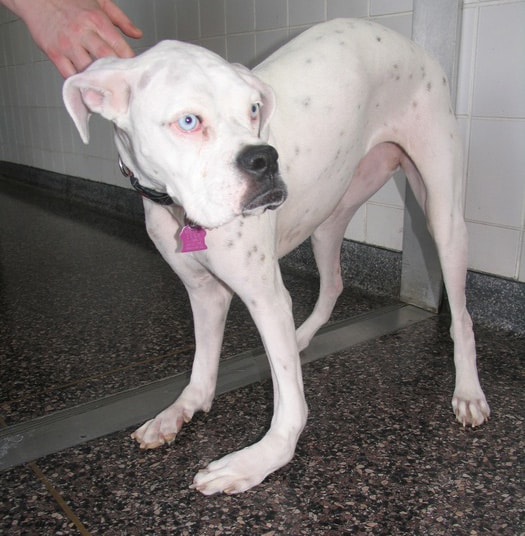
Nutrition Concerns in Large and Giant Breed Dogs
Nutrition plays a key role in your dog’s health, especially when it comes to puppies who are rapidly growing.
Poor nutrition can ultimately lead to an angular limb deformity and bowed limbs.
Large and Giant Breed dogs have different nutritional needs than smaller breeds. They need precisely balanced calcium and phosphorus ratios, as well as the correct levels of amino acids, nutrients, and fats.
Puppies who grow too quickly are at risk of developing joint problems and limb deformities, including ALD. We see this often in the Great Dane community.
Current research indicates that dogs who will be 70+ lbs as an adult (including giant breed dogs such as Great Danes) should be fed an age-appropriate large (or giant, if available) breed puppy formula.
These foods have now been formulated correctly for slow, even bone growth, while still providing the dog with enough nutrition to support building muscle and nice, tight feet.
It’s important to choose a food with Meat meal and meat by-product meals as the first ingredients. These are high-quality protein sources that contain biologically appropriate meat, bone, and organ.
If you are unsure about what type of food to feed your large or giant breed puppy, we recommend speaking to your veterinarian and referencing our articles on nutrition.
The addition of supplements, toppers, and training treats can throw off the balance of these nutrients, so keep that in mind as you are building your dog’s food bowl!
What are the Best Foods for Giant Breed Puppies?
How do I choose Dog Food when Looking at the Ingredients?
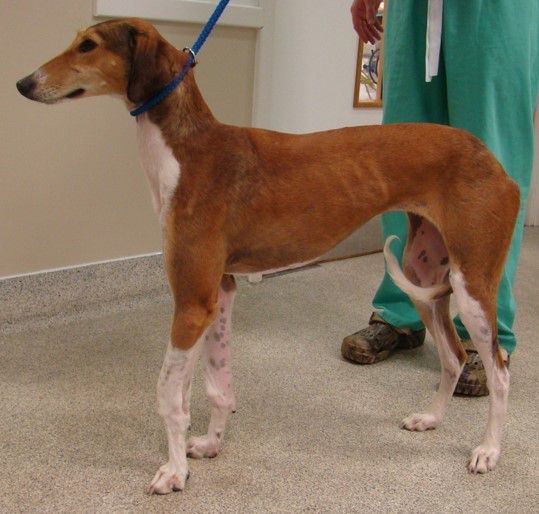
How is Angular Limb Deformity Treated
Getting a diagnosis of Angular Limb Deformity can be devastating, however, it’s important to take action quickly.
In growing dogs, Angular Limb Deformity can be progressive, and the sooner you take care of it, the better.
Depending on the complexity of surgical correction required, your dog may need to be on crate rest for weeks at a time. Restricting movement while bone healing and fusion of the bone plates take place is important.
We recommend preparing yourself financially and emotionally for this.
Understanding Limb Anatomy
There are two bones inside the front limbs of your dog. The Ulna, and the Radius.
The radius is the large weight-bearing bone. This bone is often the one that becomes deformed.
The ulna may have stopped growing (as a result of growth plate damage) and will restrict the radius from growing normally.
Orthopedic Surgery Options
There are three types of surgery offered for dogs suffering from angular deformity. The earlier it’s caught and diagnosed, the better, especially in growing puppies.
Any visible limb deformity should be evaluated by a board-certified orthopedic surgeon.
First, the surgeon will rule out other causes of bowed legs. Radiographs will be used to confirm if the deformed bones are in fact Angular Limb Deformity.
They will also evaluate how much further growth is expected, before making a recommendation. A severe deformity may result in the recommendation to amputate, rather than attempt to fix the bones of the affected forelimb.
The four types of surgical correction for limb deformities include Ulnar Ostectomy, Osteotomy, Arthrodesis, and Amputation. Read more about each option below.
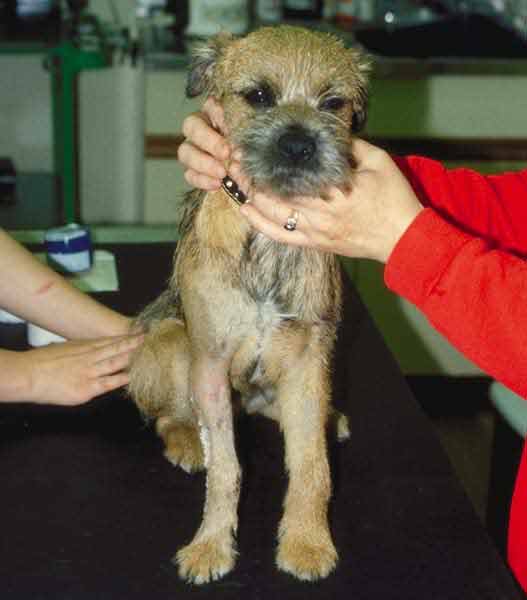
Ulnar Ostectomy
This is the most common type of surgery and is recommended for puppies under one year of age, especially for dogs that have significant remaining growth potential in the affected and normal limbs.
This procedure involves cutting and removing a portion of the deformed bone (the ulna) in the forearm or affected joint.
The radius is then allowed to rotate into its new position as the puppy finishes growing.
With this option, the ulna bone will be ‘free-floating’ from that point forward, and can no longer restrict the growth of the radius bone as it was before.
Compared to other options, this is the least-invasive choice.
However, it will be ineffective if the puppy is nearly fully grown.
With the Ulnar Ostectomy, time is of the essence.
Some dogs who undergo this procedure will still have a valgus deformity and may need additional surgeries.
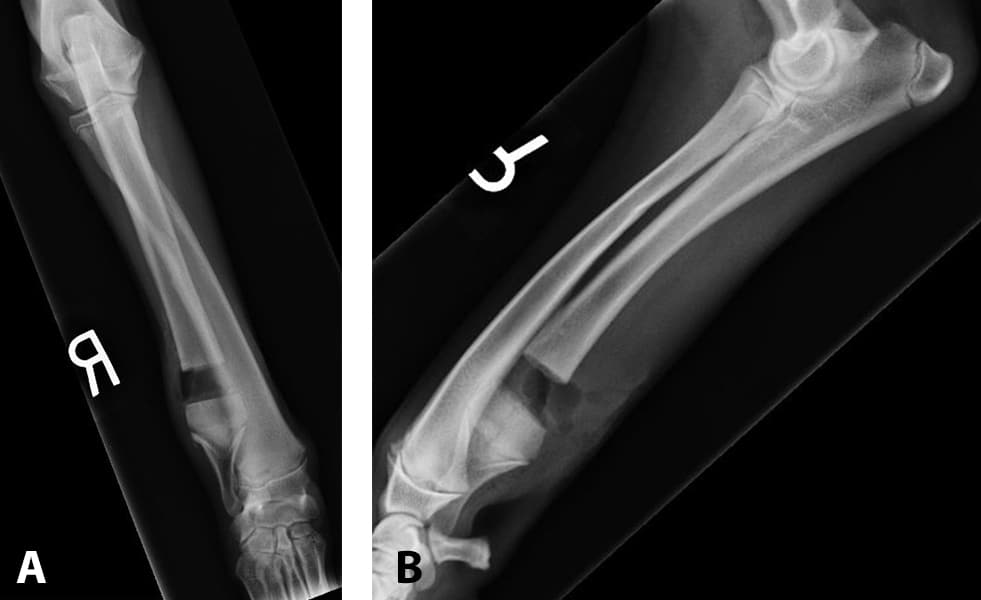
Osteotomy
This orthopedic surgery involves cutting, realigning, resetting, and pinning the bone. Metal plates and screws are commonly used to connect bone segments and joints adjacent to the deformity.
Corrective osteotomy is a more involved surgery, but it often results in a better long-term outcome for your dog.
This type of surgery is recommended for dogs over one year of age and may be necessary if the Ulnar Ostectomy (the cutting of the ulna bone) performed previously didn’t provide satisfactory results.
Many surgeons will place an external skeletal fixation device following the procedure. These look scary and can be alarming to pet parents, but will help with stabilizing the bone while it heals from surgery.
An external skeletal fixator is similar to a cast in how it functions, while still allowing the skin to breathe and heal. It is removed once the bones have fully set.
It is not uncommon for dogs with ALD to need both surgeries in the journey to restore acceptable limb function, especially for those with more severe deformities. The adjacent joints may also undergo arthrodesis (see below).
Expect your dog to need 6-8 weeks or more of crate rest, followed by physical therapy.
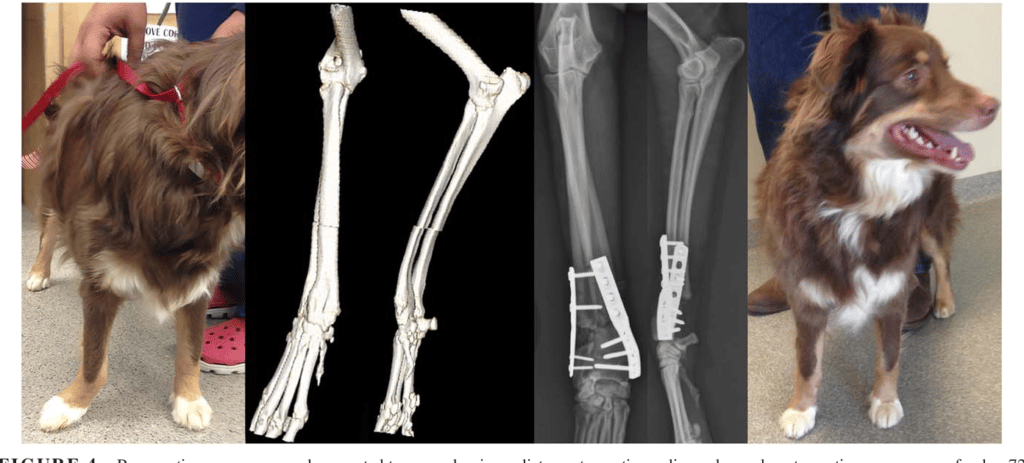
Arthrodesis
This is a newer technique that fuses the bones together using bone grafts in the affected forelimb.
Many orthopedic surgeons will choose to pair Osteotomy with Arthrodesis.
While this option may ultimately restrict some movement of the bones and joints, it can also provide a lifetime of support and pain-free living for a dog with angular deformities.
No matter which type of surgery your dog needs, it’s important to discuss all pros and cons with a board-certified Veterinary Orthopedic Surgeon.
The opposite limb can be affected in some ways, too, because of how angular limb deformities affect gait and movement.
Orthopedic limb-sparing surgery of any kind will require diligent crate rest and low activity for several weeks.
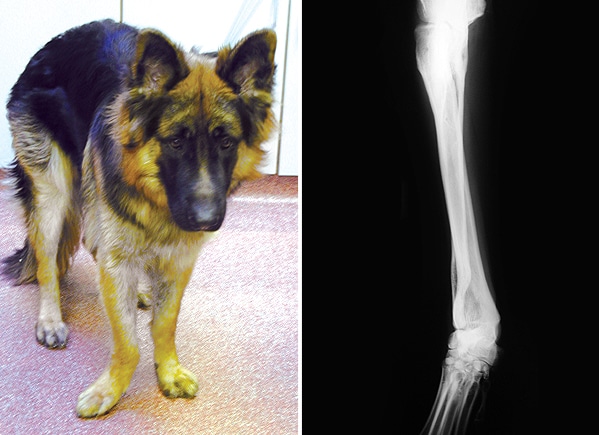
Amputation
For some dogs with a severe deformity, or dogs with small, weak or brittle bones, amputation may be advised.
This is considered a last-resort effort as it will permanently remove the use of the affected limb.
Dogs typically do very well on three legs and can lead long, happy lives, however!
Unlike the other orthopedic surgeries mentioned above, amputation has a relatively short recovery time.
It will only require crate rest for 10-14 days while the sutures heal, followed by physical therapy so your dog can build strength and balance in the remaining limbs.

Living with Angular Limb Deformities
A dog that has an Angular Limb Deformity, whether it has been amputated, surgically corrected, or not treated at all, will have special considerations when it comes to joint care, diet, and body condition.
Nutrition Support for Angular Limb Deformity
Dogs who have angular limb deformities will benefit from a correctly balanced diet.
It may be tempting to seek out holistic and natural alternatives such as home cooking, however, we advise doing so with caution.
Home-cooked diets are rarely if ever balanced correctly. They are dangerous at best.
A dog with any kind of orthopedic issue or limb deformity, especially while growing, needs a scientifically-backed balance of calcium, phosphorus, fats, and amino acids to support bone growth and healing.
It’s important to note that many ‘super-premium’ boutique dog foods that you find in the pet store or online are formulated by people with nominal, if any, nutrition or veterinary credentials. They often use ingredient splitting to trick you and may make things worse for your dog.
Make sure you are choosing dry kibble food that is formulated by veterinary nutritionists. The food you choose should have also been subjected to legitimate research and feeding trials.
We recommend choosing a kibble that is appropriate for your dog’s size and age and then using toppers (see below) to add fresh and whole foods nutrition.
Appropriate toppers for dog foods include:
Professionally balanced raw food
Dr. Harvey’s
Fresh fruit or veggies such as blueberries, green beans, spinach or shredded apples
Fish oil
Make sure that toppers comprise 10% or less of your dog’s overall food intake when choosing unbalanced options such as fruit and veggies (which can fill your dog up and make them less interested in their balanced nutrition). Don’t overdo fish oil or bone broth. Less is more!
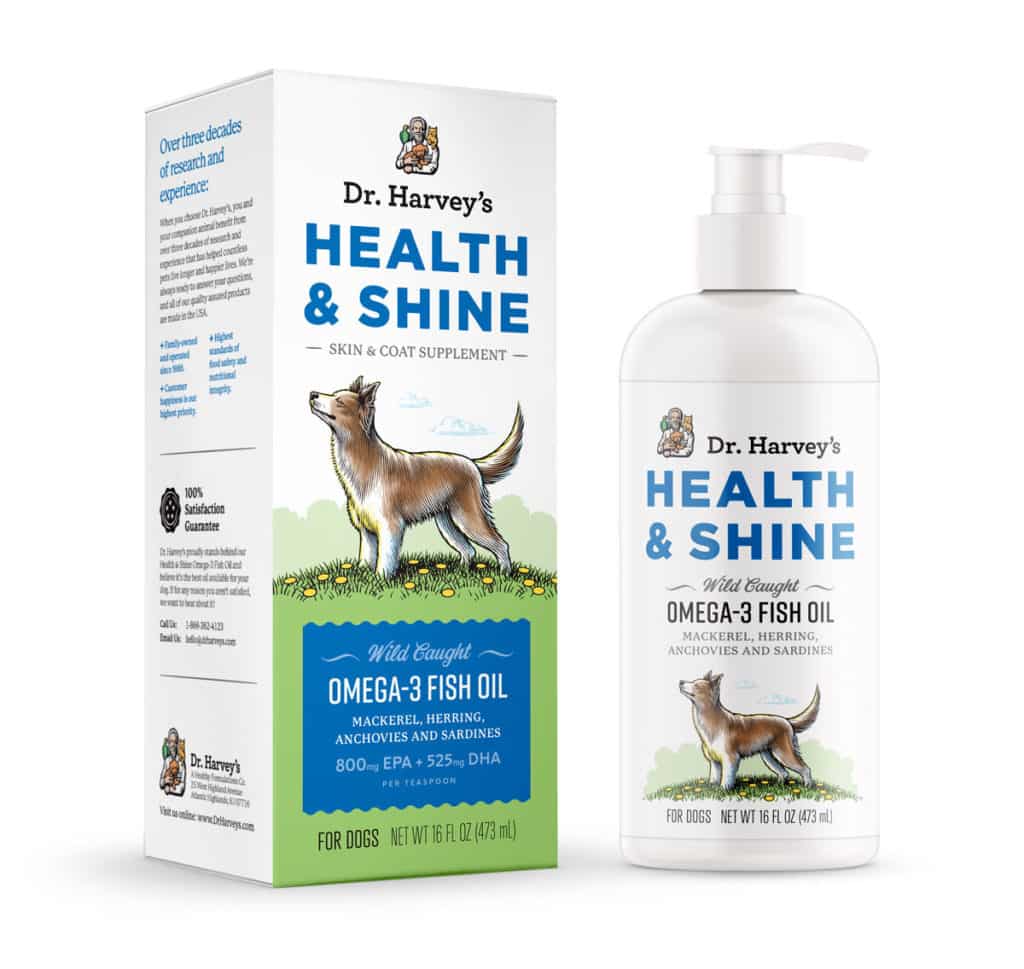
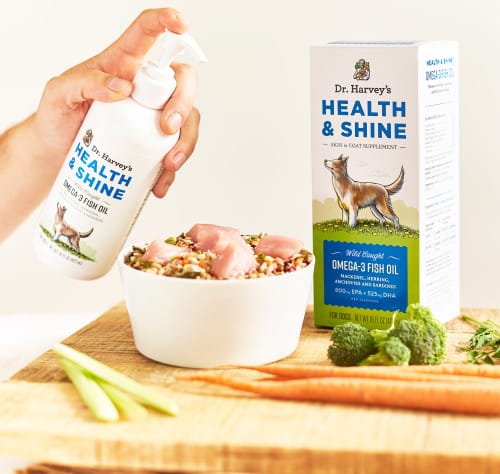
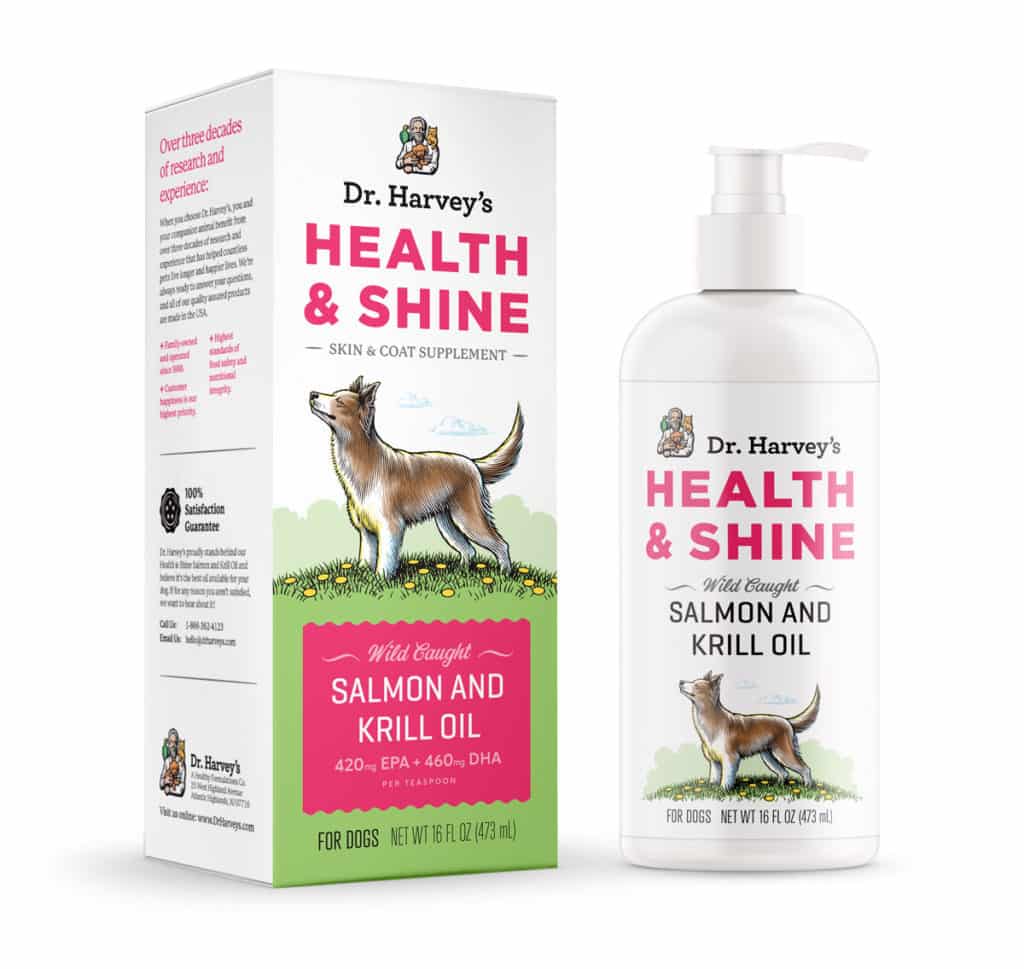
Conditioning for dogs with Angular Limb Deformities
It is extremely important to keep a dog with any kind of limb deformity strong and lean.
Extra weight puts unnecessary stress on joints, ligaments, and bones and can worsen the effects of angular limb deformity.
We recommend a combination of moderate exercise and a correctly balanced diet to help your dog maintain an ideal body condition.
The safest and most natural form of movement for a dog will be off-leash on soft, varied outdoor terrain.
For this reason, we recommend that all dogs are E-Collar trained so they can benefit from unrestricted movement and enrichment.
The soft, varied terrain will keep their muscles and feet strong, without causing additional damage to the joints.
Pavement, pulling, harnesses, head collars, hard surfaces, jumping, and sliding around can be painful and damaging to dogs with healthy joints.
Therefore, dogs with any kind of deformity or orthopedic challenge will require additional attention to their joint and muscle health and should be allowed to move as naturally as possible.
Joint Support for dogs with Angular Limb Deformity
Dogs with Angular Limb Deformity often require joint supplements and pain medication to help them stay comfortable.
Your veterinarian or orthopedic surgeon may prescribe muscle relaxers, anti-inflammatories, pain medications, and joint support.
If you choose a correctly balanced kibble with meat meal and meat by-product meal in the ingredients, Glucosamine (a joint support supplement that is naturally occurring in nutritious by-products such as chicken feet, tracheas, and cartilage) should already be naturally included in the diet.
We also recommend the following products, however, be careful not to overdo it! Too much joint support can actually be detrimental.
Talk to your veterinarian about an appropriate diet and supplements for your dog.
My Story of Angular Limb Deformity
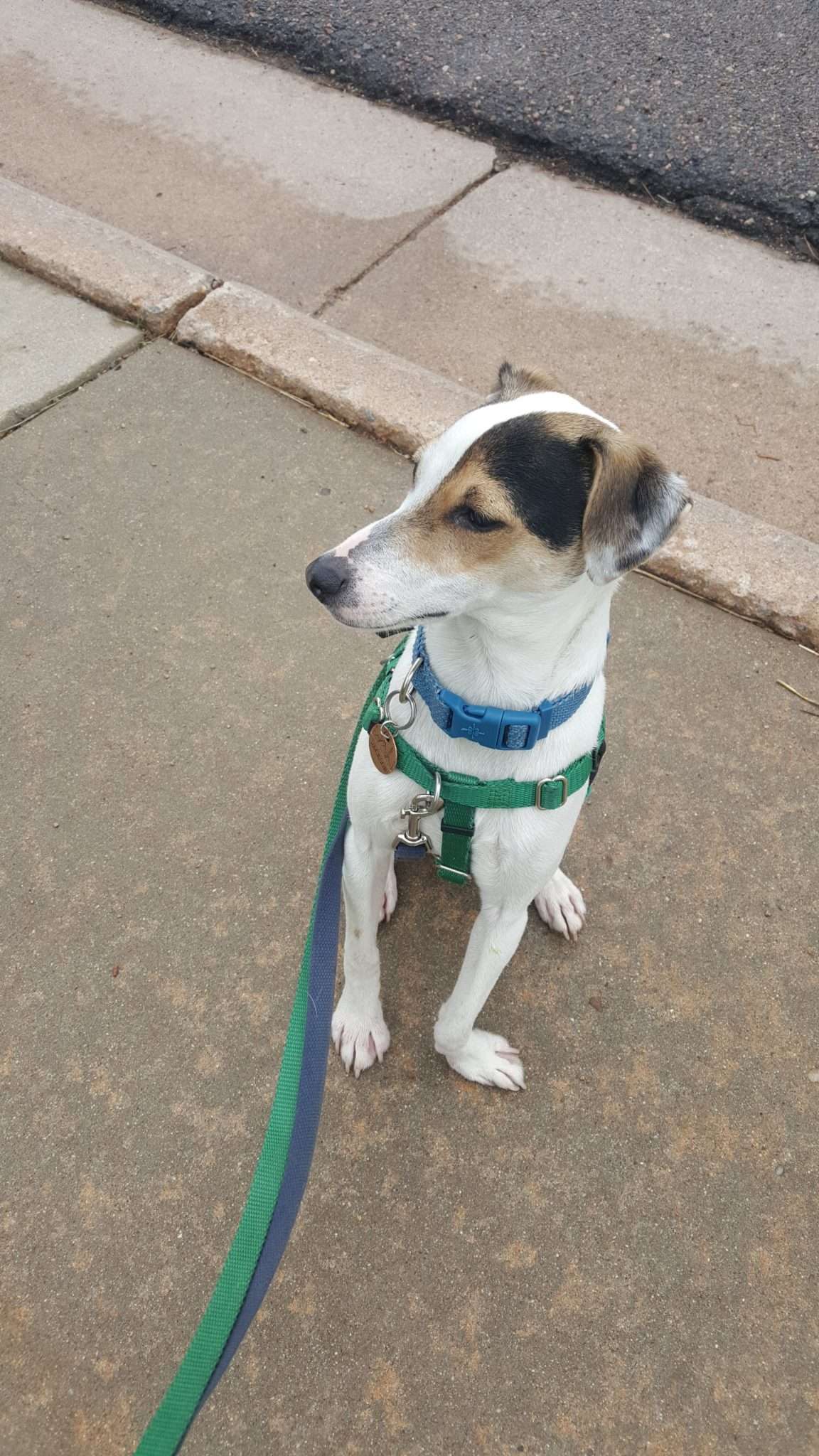
We have a small terrier who, at 14 weeks of age had a very tiny ‘greenstick’ fracture in his front limb.
The injury was very mild and required a cast and crate rest. Our veterinarian said it was fairly common and not concerning.
His final x-ray showed that he had healed perfectly, and there was no apparent damage left. It was as if it had never happened!
After having been in a cast, however, his leg was pretty weak. Our veterinarian said this was normal and that it would quickly become stronger as he was able to move, play and be a puppy.
Two days after his cast was removed, we attended (with veterinary permission) a puppy 101 training class.
The instructor, who promoted herself as a ‘positive’ dog trainer, didn’t like how he was getting excited and biting his leash.
To fix it, she spun his collar around her finger until he was choking. Then she grabbed his scruff in the same hand, picked him up off the ground, shook him, and then slammed him onto a concrete floor. She held him there until he stopped screaming.
Doing this, she caused irreparable damage to his soft growth plate and to the tendons in his leg, which just days before had been considered healed. Her training method is a form of abuse.
How to Find & Choose an Ethical Dog Trainer
Within weeks, he began to show signs of Angular Limb Deformity. I had to advocate for him; I didn’t know what ALD was but I knew something was wrong with the foot. His symptoms were very mild at first. By the time he was 6 months of age, I was alarmed.
We saw three different veterinarians in our journey to find out what was happening.
What started as a very mild deformity quickly become worse, almost overnight.
At that point, we were referred to an orthopedic surgeon, who diagnosed him with Angular Limb Deformity. He said that his tendons had also likely been stretched beyond repair by the dog trainer.
He was a candidate for Orthopedic Osteotomy (plates and screws) paired with Arthrodesis (bone fusion) to support the tendons in his foot.
We were told that because his bones were so small, there was a 40% chance these surgeries would fail, leading us to additional surgeries or amputation.
The estimated costs were running upwards of $8000-$10,000, and we were prepped to anticipate 6-8 months of crate rest and rehabilitation if we wanted our best chance at success.
We we also told that the risks associated with orthopedic surgery included bone fractures, cold intolerance (in the affected limb), and early onset arthritis.
Jackson was also a candidate for amputation of his affected limb.
He is an extremely agile and athletic dog; for this reason, we chose (under the advisement of both our veterinarian and our orthopedic surgeon) amputation.
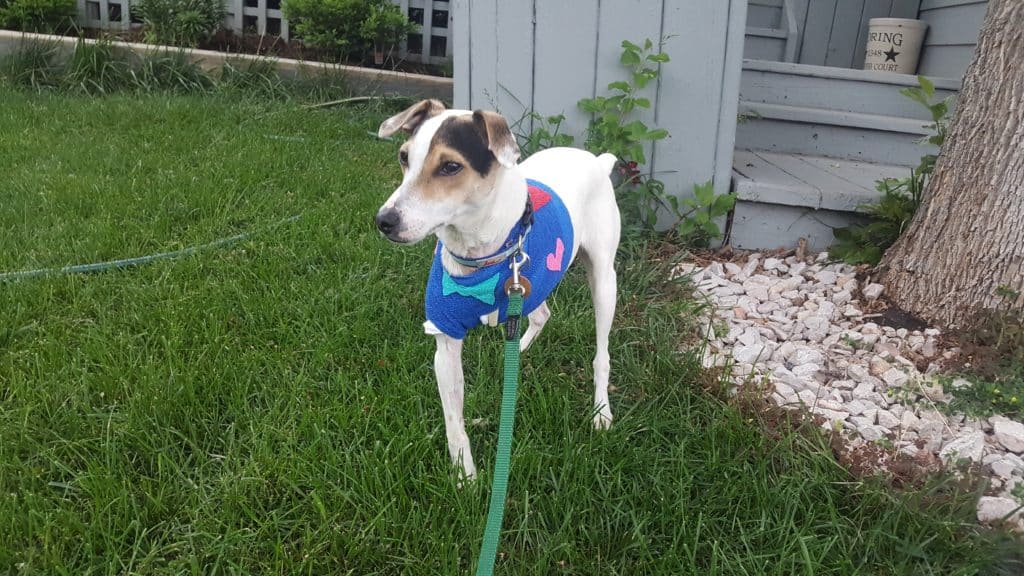
This isn’t the correct choice for all dogs, but it was for ours.
He is fast, strong, fit, balanced, and incredibly happy. Amputating his painful, damaged leg was a gift.
If you are facing an angular limb deformity diagnosis, don’t be afraid to ask questions and advocate for your pet!
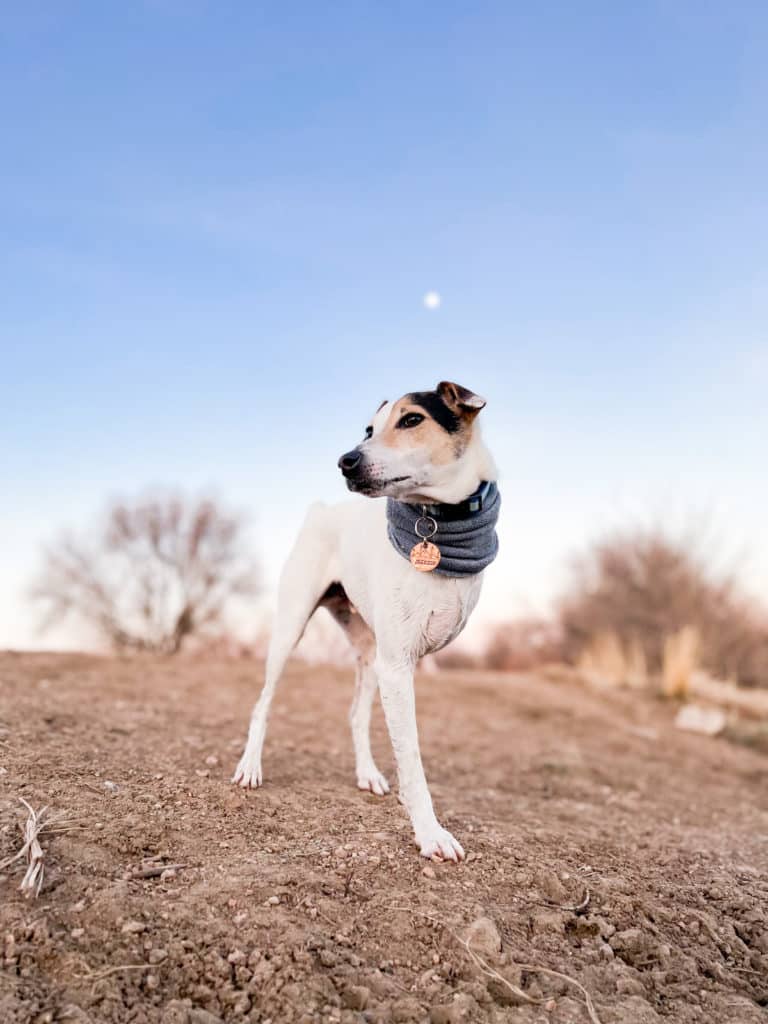
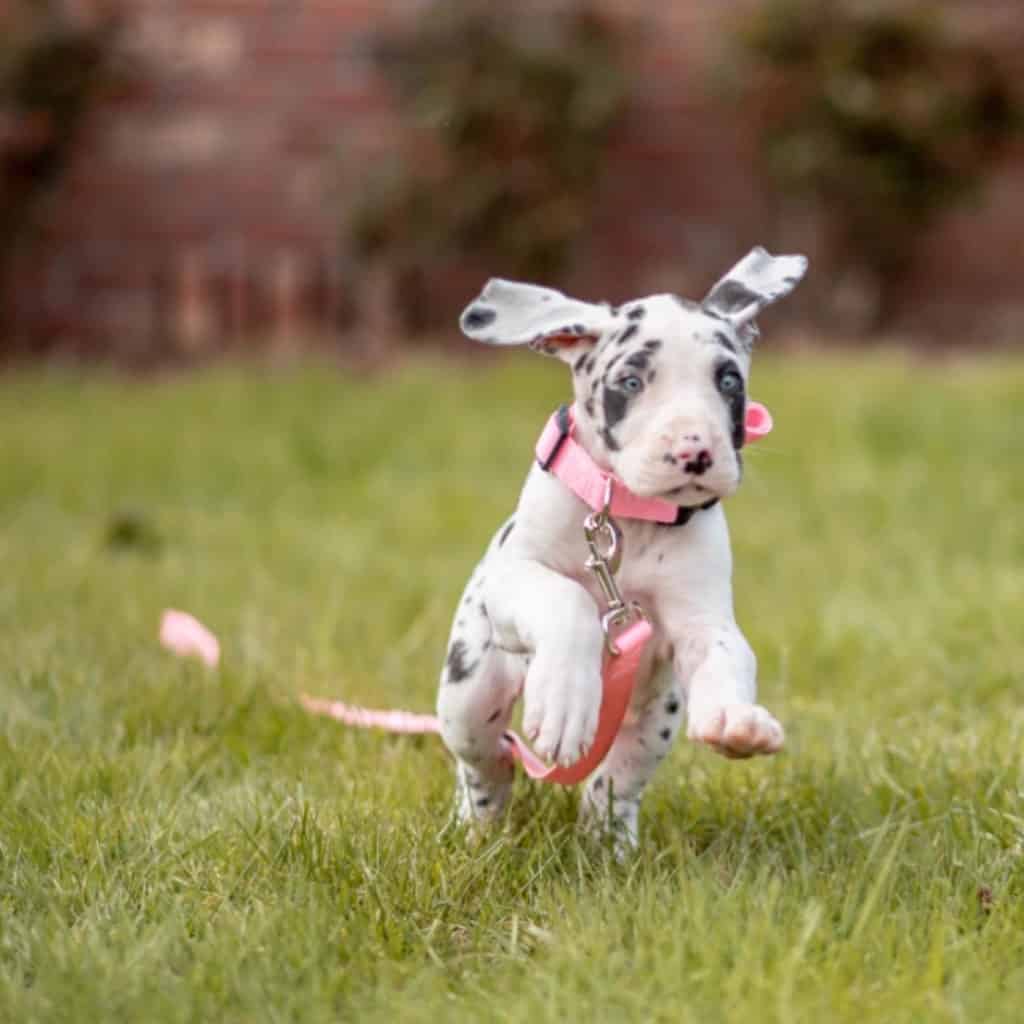
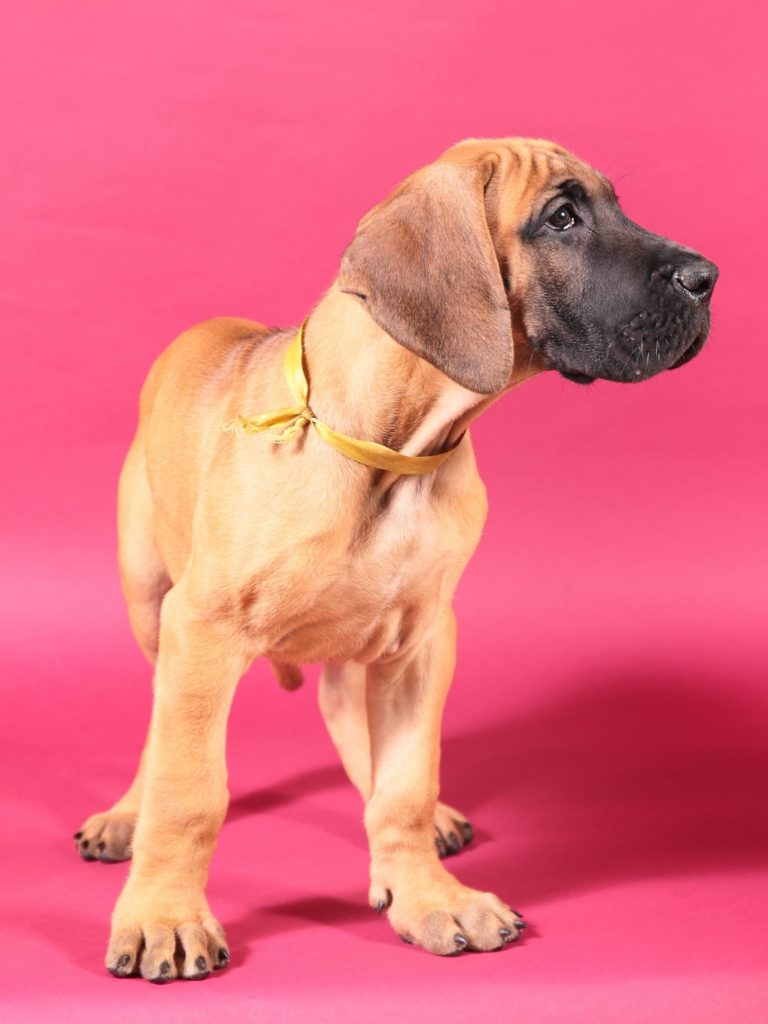
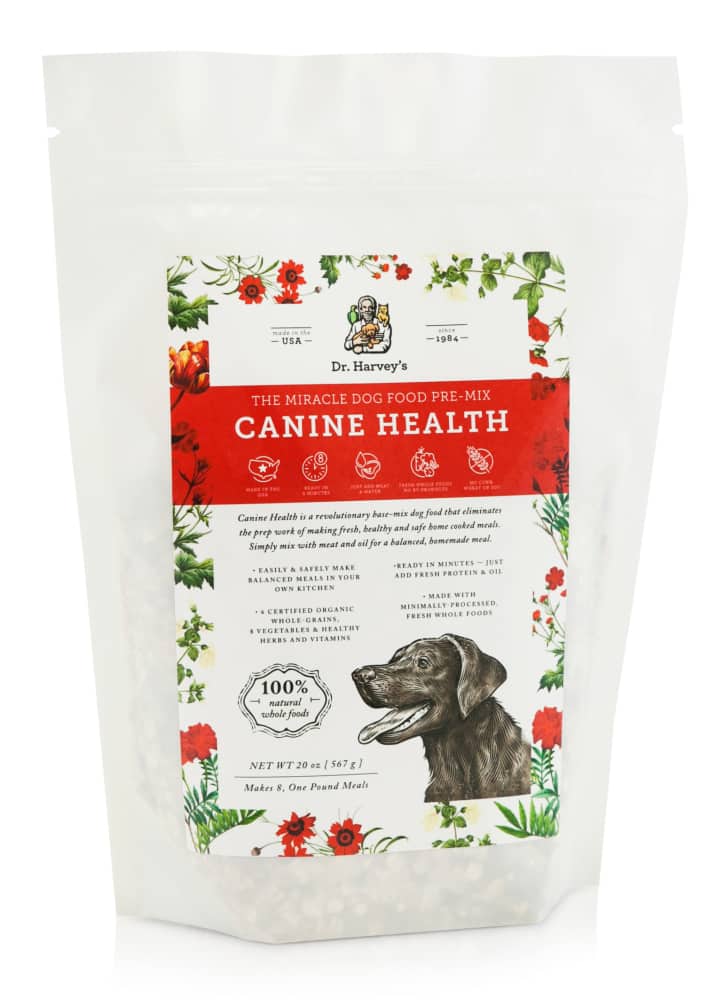
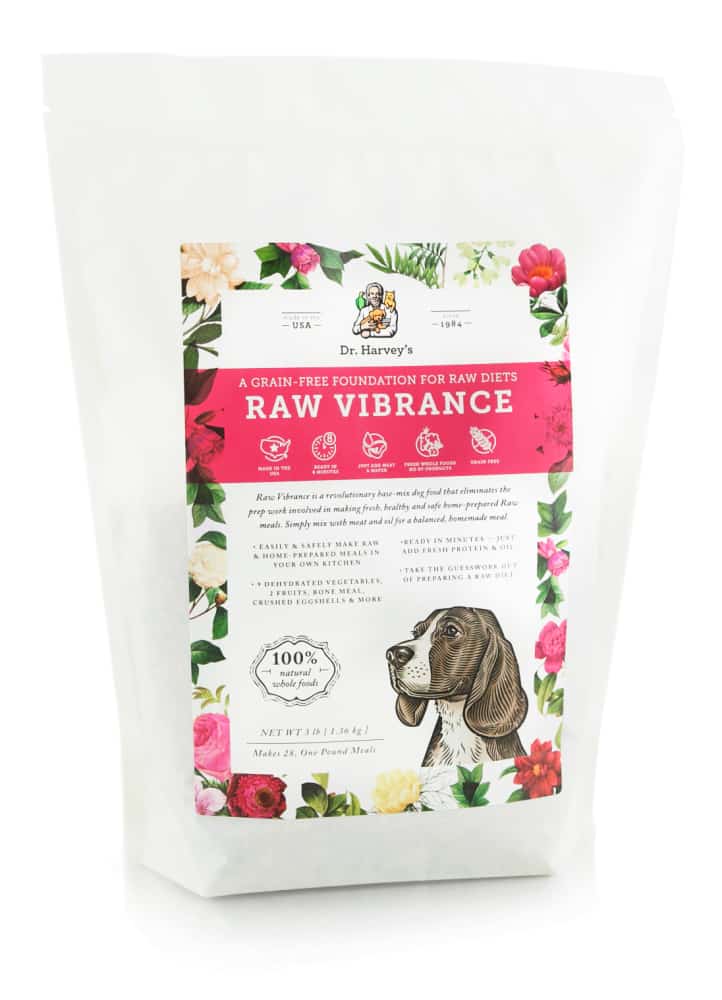
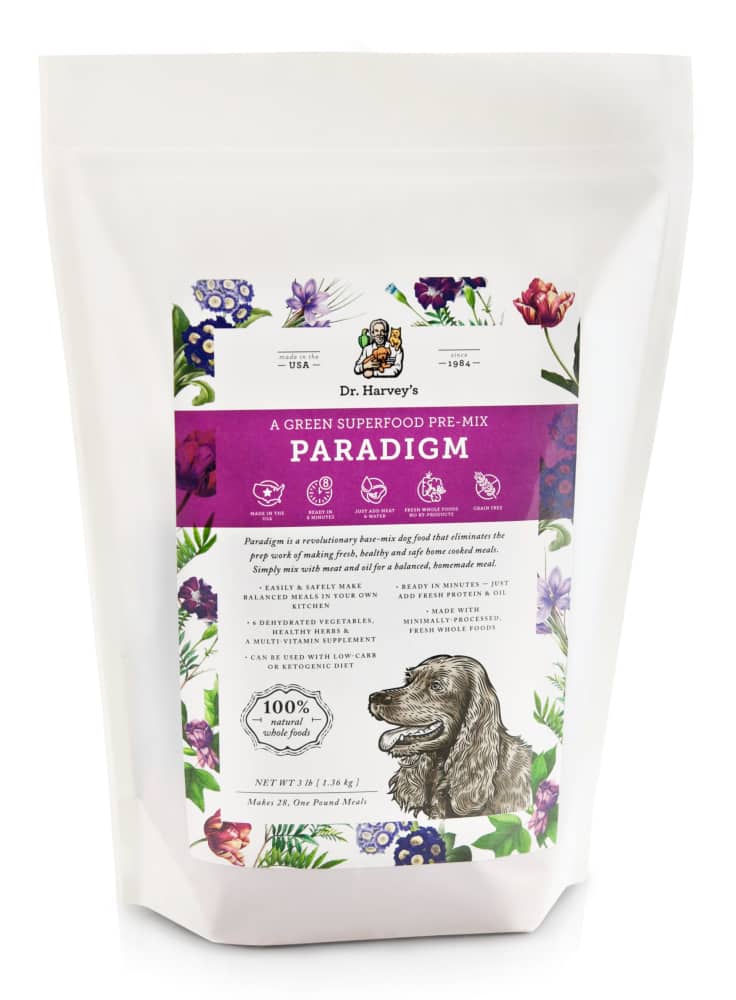
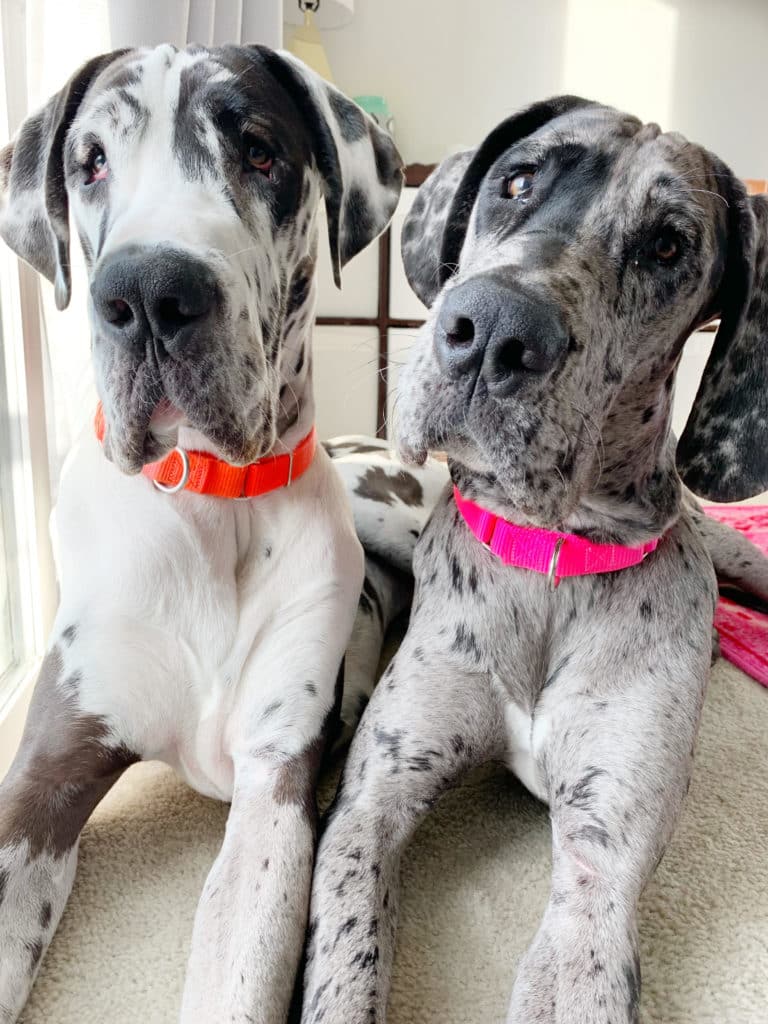
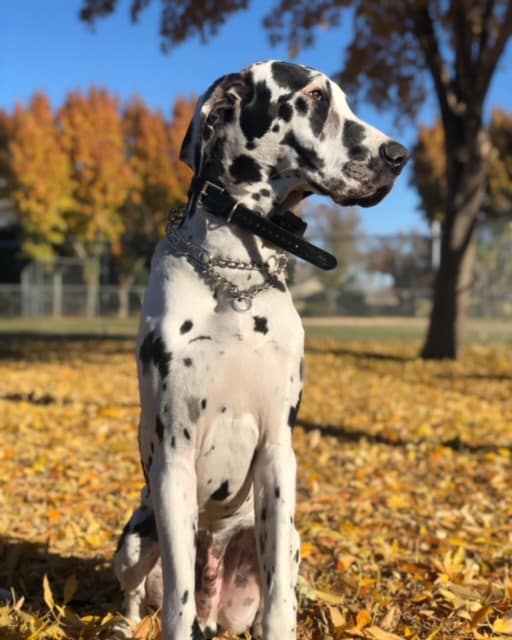
Leave a Reply